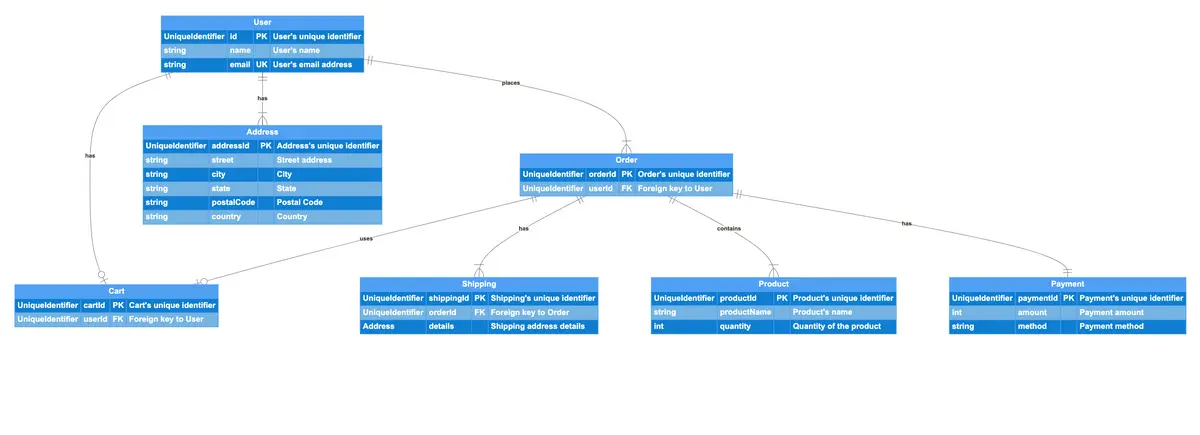In this ER diagram representing an eCommerce platform, users register with unique identifiers, names, and emails, managing multiple addresses. They place orders containing various products using carts associated with their accounts, each order linked to a payment method and amount. Shipping details are recorded for orders, allowing multiple shipments for a single order.

Edit this diagram in Gleek
E-commerce website diagram code in Gleek
User
UniqueIdentifier id PK "User's unique identifier"
string name "User's name"
string email UK "User's email address"
Order
UniqueIdentifier orderId PK "Order's unique identifier"
UniqueIdentifier userId FK "Foreign key to User"
Product
UniqueIdentifier productId PK "Product's unique identifier"
string productName "Product's name"
int quantity "Quantity of the product"
Payment
UniqueIdentifier paymentId PK "Payment's unique identifier"
int amount "Payment amount"
string method "Payment method"
Address
UniqueIdentifier addressId PK "Address's unique identifier"
string street "Street address"
string city "City"
string state "State"
string postalCode "Postal Code"
string country "Country"
Cart
UniqueIdentifier cartId PK "Cart's unique identifier"
UniqueIdentifier userId FK "Foreign key to User"
Shipping
UniqueIdentifier shippingId PK "Shipping's unique identifier"
UniqueIdentifier orderId FK "Foreign key to Order"
Address details "Shipping address details"
User{1}-has-{1..n}Address
User{1}-has-{01}Cart
Order{1}-uses-{01}Cart
Order{1}-has-{1..n}Shipping
User {1}-places-{1..n} Order
Order {1}-contains-{1..n} Product
Order {1}-has-{1} Payment
About ER diagrams
We often make an entity-relationship (ER) diagram, ERD, or entity-relationship model, in the early stages of designing a database. An ERD is perfect for quickly sketching out the elements needed in the system. The ERD explains how the elements interact. ER diagrams can be shared with colleagues. Their simplicity makes them ideal even for non-technical stakeholders.
Similar ER diagram examples
Online store entity-relationship diagram
Student management system entity-relationship diagram
Online shopping entity-relationship diagram
Banking system entity-relationship diagram
Online doctor appointment system ER diagram
Daily expense tracker entity-relationship
Inventory management system ER diagram
Social media platform entity-relationship diagram
Travel management system Er diagram